Tennessee is a delightful haven for bird enthusiasts, especially for those fascinated by hummingbirds. These tiny, jewel-toned birds are not only captivating to watch but also play a vital role in pollination. From the ruby-red throat of the Ruby-throated Hummingbird to the vibrant hues of rare vagrants, Tennessee hosts a variety of hummingbirds throughout the year. Their incredible agility, hovering abilities, and fascinating behaviors make them a favorite among backyard birdwatchers and wildlife photographers alike. This guide explores the 12 types of hummingbirds in Tennessee, providing identification tips, behavior insights, habitats, diets, reproduction, and fun interactions with humans.
1. Ruby-throated Hummingbird (Archilochus colubris)

One of Tennessee’s most iconic hummingbirds, the Ruby-throated Hummingbird dazzles with its shimmering red throat and rapid wing beats.
Physical Characteristics & Identification Tips
Males display a bright ruby-red throat patch (gorget), metallic green back, and white underparts. Females are more subdued with pale throats and slightly longer tails. Measuring around 3–3.5 inches, they are small but noticeable against garden flowers.
Behavior and Nesting Habits
Ruby-throated Hummingbirds are fiercely territorial, often chasing intruders from feeders and flower patches. Females construct tiny cup-shaped nests using plant fibers, spider silk, and lichens, often on horizontal branches sheltered from direct sun or wind.
Habitat and Range
These hummingbirds prefer woodland edges, gardens, and meadows. In Tennessee, they are widespread from lowland river valleys to upland forests during migration and breeding seasons.
Diet
Their diet primarily consists of nectar from flowering plants, including trumpet vine, bee balm, and cardinal flowers. They supplement with small insects and spiders for protein.
Reproduction and Life Cycle
Females lay 1–3 tiny white eggs per clutch. Incubation lasts about 12–14 days, after which chicks fledge in roughly three weeks. Typically, they have one to two broods per season in Tennessee.
Fun Facts / Traits
They can beat their wings up to 53 times per second, producing a distinctive humming sound. During migration, some Ruby-throated Hummingbirds cross the Gulf of Mexico in a single non-stop flight.
Human Interaction
Backyard feeders filled with sugar water attract these hummingbirds, offering close observation opportunities. Avoid red dyes or honey, which can harm them.
2. Rufous Hummingbird (Selasphorus rufus)

Famed for its fiery orange-red plumage, the Rufous Hummingbird is a striking visitor to Tennessee gardens during migration.
Physical Characteristics & Identification Tips
Males exhibit bright rufous-orange backs and throats, while females show green backs with orange-tinted flanks. Their small size, about 3 inches long, and slightly forked tails distinguish them from other hummingbirds.
Behavior and Nesting Habits
Rufous Hummingbirds are exceptionally aggressive, often displacing larger species from feeders. They are primarily migratory in Tennessee, and nesting is rare here; most breed in the Pacific Northwest.
Habitat and Range
They favor open fields, forest edges, and backyard gardens rich in nectar. In Tennessee, sightings usually occur during spring and fall migration.
Diet
These birds feed on nectar from tubular flowers, such as columbines and penstemons, and hunt small insects mid-air for protein.
Reproduction and Life Cycle
While Tennessee is mostly a stopover, their reproductive cycle occurs further west. Females lay 2 eggs in compact nests attached to sheltered branches.
Fun Facts / Traits
Despite their tiny size, Rufous Hummingbirds hold some of the longest migratory routes relative to body size, often traveling thousands of miles each year.
Human Interaction
Birdwatchers cherish Rufous Hummingbirds for their vibrant colors and feisty personalities. They readily visit backyard feeders along migration paths.
3. Black-chinned Hummingbird (Archilochus alexandri)

Recognizable by its dark throat and contrasting iridescent chin, the Black-chinned Hummingbird is a less common but captivating visitor in Tennessee.
Physical Characteristics & Identification Tips
Males have a blackish-purple throat and metallic green upperparts, with a grayish-white belly. Females are green above and pale below, lacking the colored throat patch. Length is approximately 3 inches.
Behavior and Nesting Habits
Black-chinned Hummingbirds are territorial and may chase away other nectar feeders. Tennessee sightings are primarily migratory; nesting is infrequent within the state.
Habitat and Range
They favor open woodlands, gardens, and edge habitats. In Tennessee, they are most often spotted during late spring and early fall migration.
Diet
Nectar from tubular flowers dominates their diet, supplemented by insects for protein. Popular plants include bee balm, trumpet creeper, and honeysuckle.
Reproduction and Life Cycle
In their native range west of Tennessee, females construct tiny cup nests and raise 1–3 chicks per brood. Incubation lasts roughly two weeks.
Fun Facts / Traits
These hummingbirds can hover in place for extended periods and are known for their aerial agility, performing rapid side-to-side flight maneuvers when defending feeding territories.
Human Interaction
Backyard feeders in Tennessee attract occasional Black-chinned Hummingbirds. Gardeners who maintain native flowering plants improve their chances of sightings.
4. Calliope Hummingbird (Selasphorus calliope)
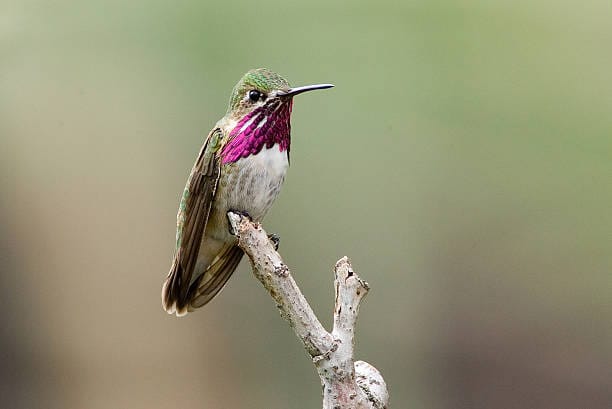
The Calliope Hummingbird, North America’s smallest long-distance migrant, brings delicate charm to Tennessee gardens during spring and fall migration.
Physical Characteristics & Identification Tips
Measuring only about 3 inches, males feature striking magenta throat streaks and greenish backs, while females are green above with a pale belly and subtle throat spots. Their tiny size and quick wingbeats make them both elusive and fascinating to observe.
Behavior and Nesting Habits
Calliope Hummingbirds are highly territorial around food sources, chasing away intruders much larger than themselves. Nesting occurs mainly in the northwestern U.S., so Tennessee visitors are typically transient, stopping briefly at feeders and nectar-rich gardens.
Habitat and Range
They prefer open woodland edges, gardens, and areas with abundant flowering shrubs. Tennessee sightings occur primarily during migration from western breeding grounds to southern wintering areas.
Diet
Primarily nectar feeders, Calliope Hummingbirds favor trumpet-shaped flowers and complement their diet with small insects for essential protein.
Reproduction and Life Cycle
Nesting is rare in Tennessee. In their primary range, females lay 2 eggs in cup-shaped nests secured with plant fibers and spider silk. Fledging occurs about three weeks after hatching.
Fun Facts / Traits
Despite their small size, these hummingbirds undertake a migration of thousands of miles, showcasing remarkable endurance and navigational skill.
Human Interaction
Gardeners in Tennessee can entice Calliope Hummingbirds with small, nectar-filled feeders and native flowering plants, providing an opportunity to observe their delicate beauty up close.
5. Allen’s Hummingbird (Selasphorus sasin)
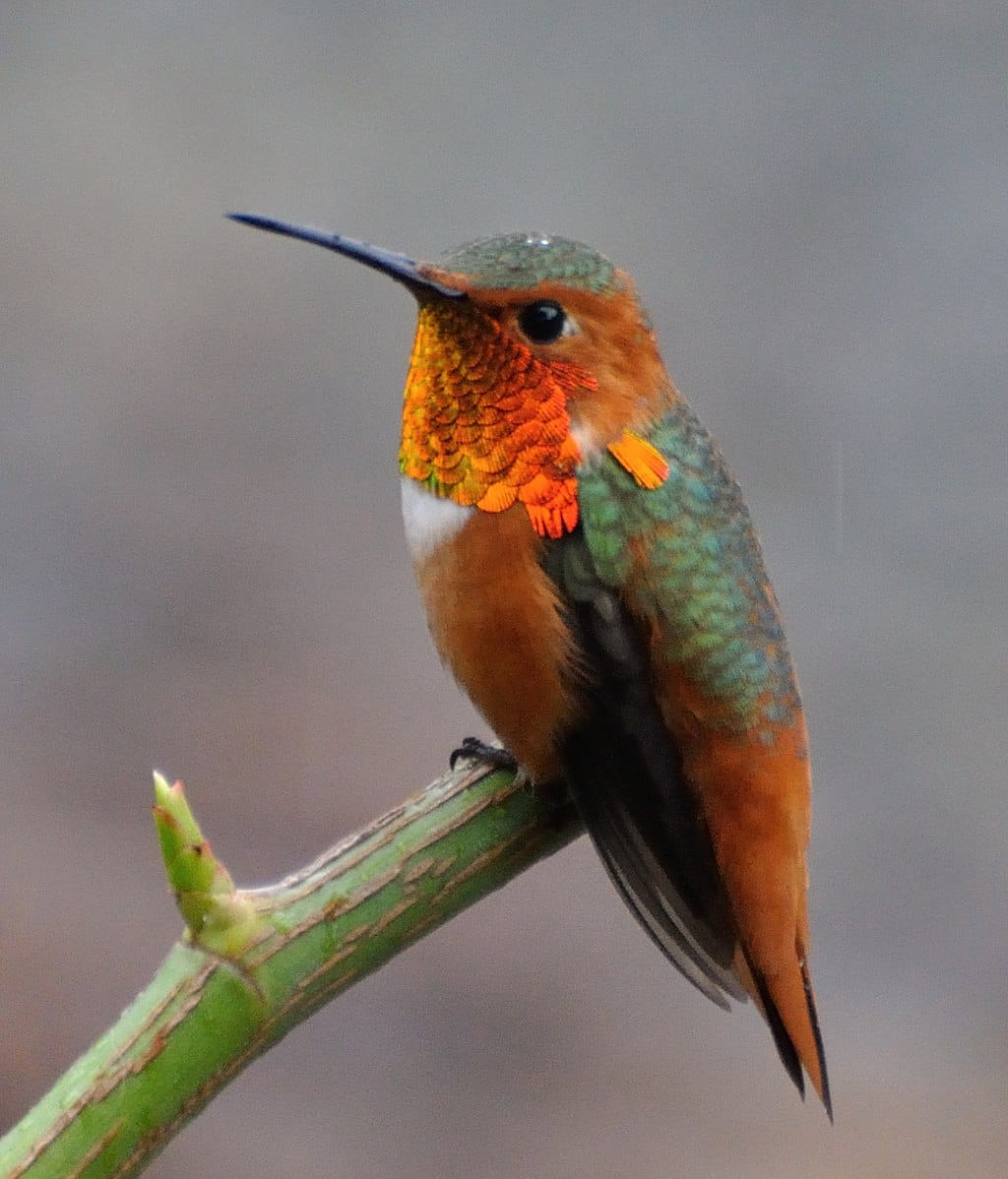
Allen’s Hummingbird is a rare but captivating visitor in Tennessee, known for its vibrant orange and green plumage and energetic behavior.
Physical Characteristics & Identification Tips
Males have bright orange backs and throats with greenish tops, while females display green backs with orange-tinted flanks. Length averages 3 inches. Their slightly forked tails and contrasting colors make identification straightforward during migration.
Behavior and Nesting Habits
Allen’s Hummingbirds are territorial, often displaying aerial dives to defend feeding areas. In Tennessee, nesting is almost nonexistent; most sightings occur during spring and fall migration.
Habitat and Range
They thrive in gardens, woodland edges, and open meadows. Tennessee sightings are sporadic, often linked to gardens rich in nectar sources along migratory paths.
Diet
Their diet includes nectar from tubular flowers such as columbines, penstemons, and honeysuckle, along with small insects for protein.
Reproduction and Life Cycle
Although Tennessee is outside their breeding range, in native habitats, females lay 2–3 eggs per clutch in small nests on sheltered branches. Fledging occurs around three weeks after hatching.
Fun Facts / Traits
Allen’s Hummingbirds are highly energetic and are among the most aggressive nectar defenders despite their small size.
Human Interaction
Backyard feeders and native flower gardens increase the likelihood of Allen’s Hummingbird sightings in Tennessee. Birders prize these rare visits for their vivid coloration and bold behavior.
6. Anna’s Hummingbird (Calypte anna)

Anna’s Hummingbird, more commonly a West Coast resident, occasionally appears in Tennessee, captivating observers with its bold behavior and metallic hues.
Physical Characteristics & Identification Tips
Males showcase iridescent rose-red crowns and throats with green backs, while females are green above with pale underparts and subtle throat spots. Their size ranges from 3 to 3.5 inches.
Behavior and Nesting Habits
Anna’s Hummingbirds are confident and often feed near humans. Tennessee sightings are usually non-breeding, with birds taking advantage of backyard feeders and flowering plants.
Habitat and Range
They favor gardens, parks, and open woodland areas. In Tennessee, their presence is transient, appearing mostly during the winter or migration periods.
Diet
Anna’s Hummingbirds feed on nectar from tubular flowers, suet feeders, and small insects. They are adaptable and readily explore artificial feeders in urban and suburban settings.
Reproduction and Life Cycle
Breeding generally occurs on the West Coast. Females construct cup-shaped nests using plant fibers and spider silk. Incubation lasts 14–16 days, and fledging occurs around three weeks.
Fun Facts / Traits
Anna’s Hummingbirds can survive in colder temperatures than most species, enabling them to winter farther north than expected.
Human Interaction
These bold hummingbirds are drawn to feeders and flowers in Tennessee, offering close-up viewing opportunities. Their inquisitive nature makes them a favorite among backyard birdwatchers.
7. Broad-tailed Hummingbird (Selasphorus platycercus)
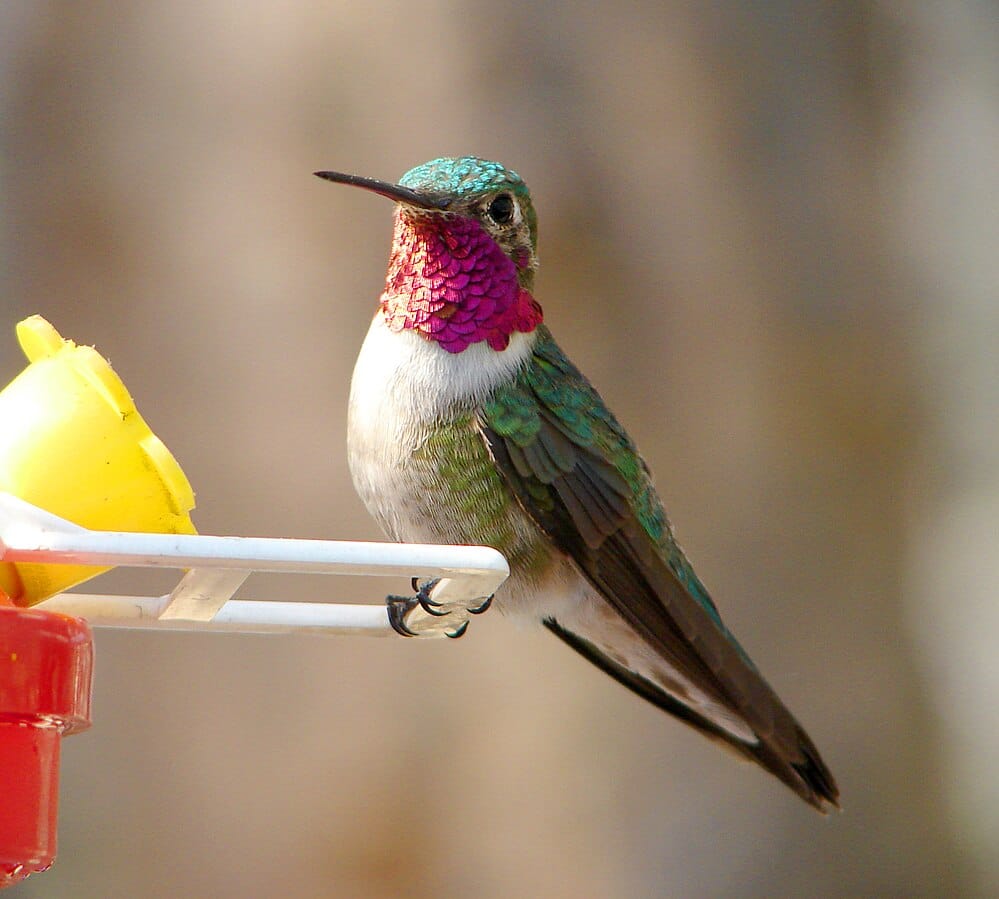
Broad-tailed Hummingbirds are rare migratory visitors to Tennessee, recognized for their striking green backs and rose-pink throats.
Physical Characteristics & Identification Tips
Males measure approximately 3.5 inches and display iridescent rose-red throats, green backs, and white underparts, with slightly forked tails. Females are more subdued, with greenish backs and pale throats. Their hovering behavior and broad tails distinguish them from similar species.
Behavior and Nesting Habits
They are territorial at feeders and flowers, performing aerial displays to ward off competitors. Tennessee visitors are typically transient during migration, so nesting is rare in this state.
Habitat and Range
Broad-tailed Hummingbirds prefer open woodlands, forest edges, and meadows with abundant nectar. In Tennessee, sightings are usually linked to feeders in gardens along migratory corridors.
Diet
Their diet includes nectar from tubular flowers such as columbine and penstemon, supplemented with insects and spiders for protein.
Reproduction and Life Cycle
In their primary breeding grounds in the western U.S., females lay 2 eggs in small cup-shaped nests attached to sheltered branches. Fledging occurs around three weeks after hatching.
Fun Facts / Traits
Broad-tailed Hummingbirds produce a distinctive buzzing sound with their wings, audible even from a short distance.
Human Interaction
Gardeners can attract these occasional Tennessee visitors using nectar feeders and planting native tubular flowers.
8. Broad-billed Hummingbird (Cynanthus latirostris)

Broad-billed Hummingbirds, with their vivid green and blue coloration, are uncommon yet striking visitors to Tennessee.
Physical Characteristics & Identification Tips
Males feature bright metallic green bodies, cobalt-blue throats, and red bills with black tips. Females are duller green with paler throats. They measure around 3.5 inches in length. The striking contrast in males makes identification relatively easy.
Behavior and Nesting Habits
These hummingbirds are aggressive feeders, chasing intruders from nectar sources. In Tennessee, they do not typically breed; most observations occur during rare migration events.
Habitat and Range
They prefer arid scrub, gardens, and forest edges. Tennessee sightings are exceptional, often reported in southern counties near gardens with abundant flowers.
Diet
Broad-billed Hummingbirds feed mainly on nectar from tubular flowers and consume small insects and spiders for protein.
Reproduction and Life Cycle
In their native breeding areas in the southwestern U.S. and Mexico, females build small cup-shaped nests using plant fibers and spider silk. Incubation lasts about two weeks, with fledging occurring three weeks post-hatch.
Fun Facts / Traits
Males perform dramatic dive displays to court females, showcasing their brilliant throat coloration.
Human Interaction
Providing feeders and planting nectar-rich flowers in Tennessee gardens can occasionally attract Broad-billed Hummingbirds for close observation.
9. Buff-bellied Hummingbird (Amazilia yucatanensis)

Buff-bellied Hummingbirds are infrequent visitors to Tennessee, recognized for their subtle coppery-green bodies and warm buff underparts.
Physical Characteristics & Identification Tips
These hummingbirds measure roughly 3.5 inches. Males display coppery-green upperparts and warm buff-colored bellies with slight reddish throat highlights. Females are duller with paler throats. Their size and coloration help distinguish them from other occasional visitors.
Behavior and Nesting Habits
Buff-bellied Hummingbirds are curious and energetic at feeders, often exploring multiple nectar sources. Tennessee sightings are typically limited to migration, so nesting is uncommon.
Habitat and Range
They favor gardens, forest edges, and open scrublands. Tennessee sightings generally occur in southern regions where nectar sources are abundant.
Diet
Buff-bellied Hummingbirds primarily feed on flower nectar and small insects, supplementing protein needs for energy-intensive flights.
Reproduction and Life Cycle
In native breeding areas, females build cup-shaped nests with plant fibers and spider silk. Clutches usually consist of two eggs, with fledging occurring around three weeks after hatching.
Fun Facts / Traits
They are known for their calm demeanor at feeders, making them easier to observe than some more aggressive species.
Human Interaction
Gardeners providing nectar feeders and native flowering plants in Tennessee may occasionally welcome these charming birds for short visits.
10. Mexican Violetear (Colibri thalassinus)

Mexican Violetears are rare, striking hummingbirds, occasionally reported in Tennessee during unusual migration events.
Physical Characteristics & Identification Tips
Males feature brilliant emerald-green bodies with vivid violet ear patches and long, slightly curved bills. Females are similar but with paler underparts and less prominent ear coloring. Measuring about 4 inches, they are among the larger hummingbirds that may appear in Tennessee.
Behavior and Nesting Habits
These hummingbirds are highly territorial at nectar sources, performing rapid chases to deter intruders. In Tennessee, they are almost exclusively transient visitors and do not typically breed in the state.
Habitat and Range
Native to Central America, Mexican Violetears prefer humid forests and gardens with abundant nectar. Tennessee sightings are rare and usually occur in southern counties with flowering gardens.
Diet
Their diet consists mainly of flower nectar, supplemented with small insects and spiders, providing protein for high-energy hovering flights.
Reproduction and Life Cycle
In their native range, females build cup-shaped nests on branches, incubate 2 eggs for about two weeks, and fledge chicks after roughly three weeks. Tennessee visitors are generally too transient to reproduce.
Fun Facts / Traits
Mexican Violetears are known for their incredible hovering stability and can remain suspended midair while feeding from difficult-to-reach flowers.
Human Interaction
Providing nectar feeders and planting tubular flowers in Tennessee gardens can occasionally attract these vivid and rare visitors for observation.
11. Violet‑crowned Hummingbird (Ramosomyia violiceps)
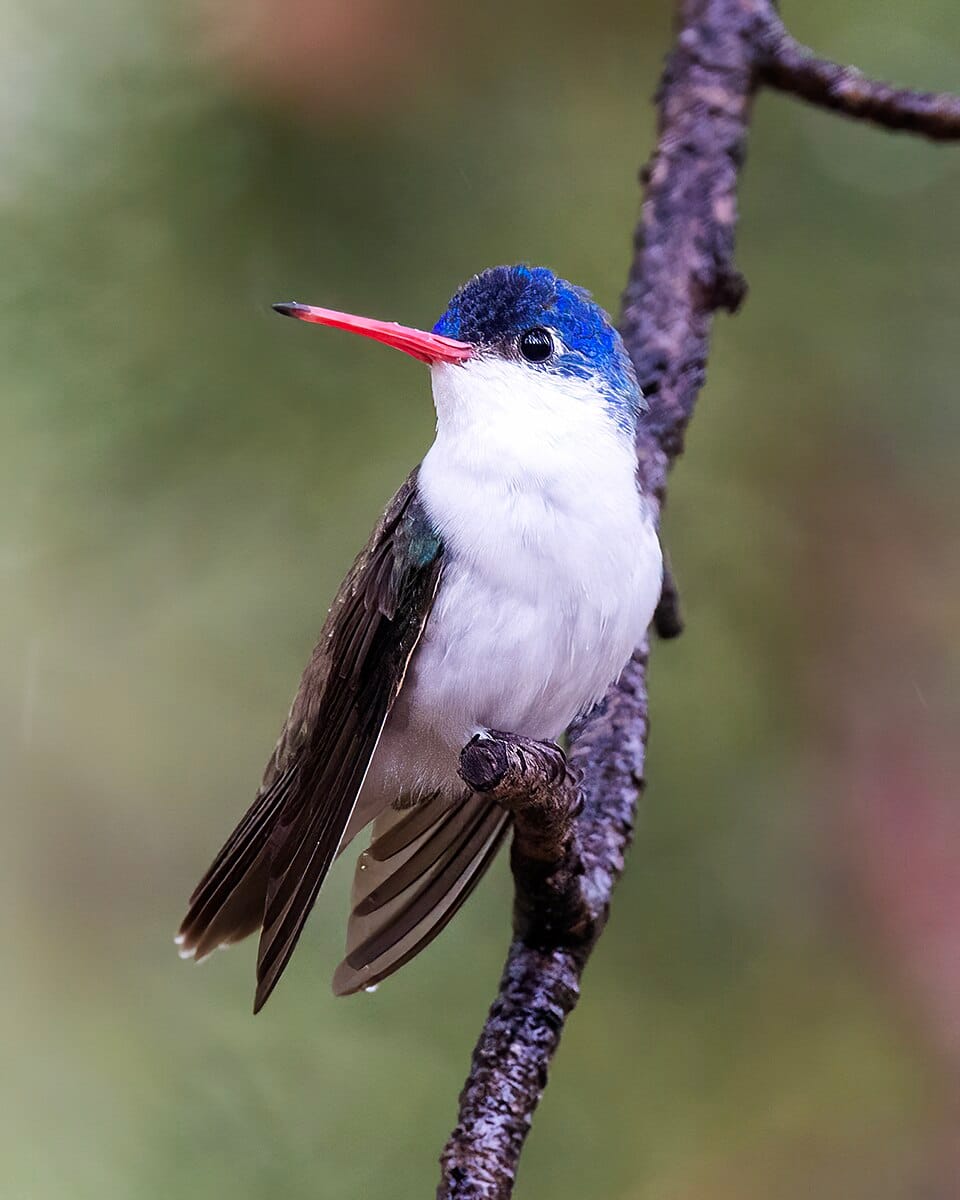
Violet-crowned Hummingbirds are extremely rare in Tennessee, typically appearing as accidental visitors during migration or unusual weather events.
Physical Characteristics & Identification Tips
These medium-sized hummingbirds measure about 3.5 inches. Males display a distinctive violet crown, green back, and white underparts, while females have muted crown colors. Their contrasting crown and body colors make them identifiable among Tennessee vagrants.
Behavior and Nesting Habits
In Tennessee, they are observed at feeders or gardens for brief periods. Nesting does not occur locally, as sightings are sporadic.
Habitat and Range
Native to arid and semi-arid regions of Mexico, they prefer scrublands and edges of woodlands. Tennessee sightings are extremely rare, often noted in southern regions during migration.
Diet
Violet-crowned Hummingbirds feed on nectar from tubular flowers and consume small insects and spiders for protein, even during short Tennessee visits.
Reproduction and Life Cycle
In their natural range, females build small cup-shaped nests and lay 2 eggs. Incubation lasts about 14–16 days, with fledging occurring three weeks later. Tennessee birds are too transient to reproduce locally.
Fun Facts / Traits
They have remarkable agility in flight, capable of hovering and rapid directional changes while foraging.
Human Interaction
Rare observers in Tennessee may attract these hummingbirds with feeders and flowering plants, enjoying brief but vivid encounters.
12. Green‑violetear Hummingbird (synonym: Mexican Violetear) (Colibri thalassinus)
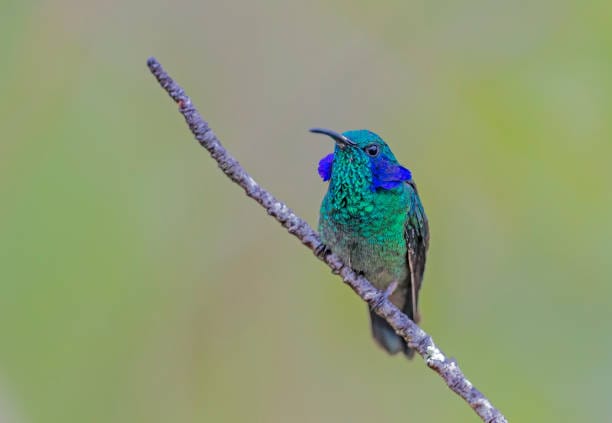
The Green‑violetear is essentially the same as the Mexican Violetear, occasionally recorded in Tennessee under rare migration events.
Physical Characteristics & Identification Tips
Identical to the Mexican Violetear, males display green plumage with violet ear patches, and females are slightly paler. Length averages 4 inches, making them larger than most local hummingbirds.
Behavior and Nesting Habits
They are territorial at nectar sources, defending flowers vigorously. Tennessee sightings are transient, with no nesting occurring locally.
Habitat and Range
Native to Central America and parts of Mexico, these hummingbirds favor humid forests and gardens. Sightings in Tennessee are extremely uncommon, usually associated with gardens providing nectar feeders.
Diet
They feed on flower nectar and small insects, providing essential energy for their hovering flights during migration.
Reproduction and Life Cycle
In their natural range, females construct small nests, lay two eggs, and raise chicks over roughly three weeks. Tennessee visitors are too fleeting to breed locally.
Fun Facts / Traits
Green‑violetears are excellent hoverers and can feed while suspended for extended periods, making them a spectacular sight even during brief Tennessee appearances.
Human Interaction
By providing feeders and flowering plants, Tennessee bird enthusiasts may enjoy rare, fleeting encounters with this dazzling hummingbird.
Conclusion: Observing Hummingbirds in Tennessee
Tennessee offers a fascinating glimpse into the world of hummingbirds, with 12 species ranging from the common Ruby-throated Hummingbird to rare vagrants like the Violet-crowned and Mexican Violetear. While some species migrate through the state, others may occasionally appear in gardens, providing birdwatchers and enthusiasts a chance to witness their dazzling plumage and acrobatic flight.
By planting native flowering plants, maintaining nectar feeders, and offering safe environments, Tennesseans can support these tiny avian marvels during their brief visits. Observing their behavior, feeding habits, and unique traits up close provides both enjoyment and a deeper appreciation for Tennessee’s rich avian diversity.
Whether you are a seasoned birdwatcher or a curious beginner, the types of hummingbirds in Tennessee present an engaging way to connect with nature, learn about migration patterns, and marvel at the remarkable energy and agility of these jewel-like birds. Each sighting is an invitation to explore, appreciate, and help protect the habitats that allow these captivating creatures to thrive.
Frequently Asked Questions About Hummingbirds in Tennessee
1. What types of hummingbirds are commonly found in Tennessee?
Tennessee hosts a variety of hummingbirds including Ruby-throated, Calliope, Allen’s, Anna’s, and occasional vagrants like the Violet-crowned Hummingbird.
2. When is the best time to see hummingbirds in Tennessee?
Late spring through early fall is the peak season for observing hummingbirds in Tennessee during migration and breeding periods.
3. How many species of hummingbirds visit Tennessee each year?
Typically, 10–12 species are observed regularly in Tennessee, with some rare visitors appearing occasionally.
4. Are Ruby-throated Hummingbirds the most common in Tennessee?
Yes, Ruby-throated Hummingbirds are by far the most frequently seen hummingbirds in Tennessee.
5. Can Calliope Hummingbirds be spotted in Tennessee?
Calliope Hummingbirds are rare visitors in Tennessee, mostly seen during migration periods.
6. What habitats do hummingbirds prefer in Tennessee?
Hummingbirds in Tennessee prefer gardens, woodlands, forest edges, and areas rich in flowering plants.
7. Do hummingbirds migrate through Tennessee?
Yes, Tennessee lies along the migration routes for many hummingbirds traveling between breeding and wintering grounds.
8. How can I attract hummingbirds to my Tennessee backyard?
Plant native nectar-rich flowers, set up red feeders with sugar water, and provide fresh water sources to attract hummingbirds in Tennessee.
9. What flowers are best for hummingbirds in Tennessee?
Trumpet vine, bee balm, columbine, cardinal flower, and honeysuckle are excellent options for Tennessee gardens.
10. Are Allen’s Hummingbirds rare in Tennessee?
Yes, Allen’s Hummingbirds are occasional visitors and less frequently observed in Tennessee.
11. How do Anna’s Hummingbirds behave in Tennessee?
Anna’s Hummingbirds are bold and may feed at backyard feeders if available in Tennessee.
12. Where in Tennessee are Rivoli’s Hummingbirds most likely to appear?
Rivoli’s Hummingbirds are extremely rare in Tennessee, usually appearing in southern areas during unusual weather events.
13. Can Mexican Violetears survive winter in Tennessee?
No, they are vagrants in Tennessee and typically cannot survive the cold winter months.
14. What do hummingbirds eat in Tennessee?
They feed on nectar from flowers, supplemented with small insects and spiders for protein in Tennessee.
15. How long do hummingbirds stay in Tennessee during migration?
Migrating hummingbirds may remain a few days to a few weeks in Tennessee, depending on food and weather conditions.
16. Are there hummingbird feeders recommended for Tennessee homes?
Red feeders filled with sugar water work best; placing them near flowers in Tennessee increases visits.
17. Do hummingbirds in Tennessee face threats from predators?
Yes, domestic cats, larger birds, and occasionally snakes pose threats to hummingbirds in Tennessee.
18. How can I identify different hummingbird species in Tennessee?
Look at throat color, size, tail shape, and wing patterns. Male Ruby-throated Hummingbirds are easily identified by their red throat in Tennessee.
19. Are Broad-tailed Hummingbirds seen in Tennessee?
Broad-tailed Hummingbirds are rare visitors and sightings in Tennessee are infrequent.
20. How do hummingbirds in Tennessee choose nesting sites?
Females select branches or shrubs in sheltered areas with abundant insects and flowers to nest safely in Tennessee.
21. Can Green-breasted Mango Hummingbirds be spotted in Tennessee?
Green-breasted Mango Hummingbirds are extremely rare in Tennessee and mostly appear as vagrants.
22. What are some fun facts about hummingbirds in Tennessee?
Hummingbirds can beat their wings over 50 times per second and travel hundreds of miles during migration through Tennessee.
23. Do Tennessee hummingbirds differ from neighboring states?
Species composition and migration timing can vary slightly due to local climate and habitats in Tennessee.
24. Do hummingbirds in Tennessee prefer urban or rural areas?
They thrive in both urban and rural areas, as long as nectar sources and safe nesting sites are available in Tennessee.
25. Are there hummingbird-watching events in Tennessee?
Yes, birding clubs and wildlife organizations host annual hummingbird counts and garden tours in Tennessee.
26. How can I photograph hummingbirds in Tennessee effectively?
Use fast shutter speeds, position near feeders or flowers, and be patient for hovering shots in Tennessee.
27. What is the lifespan of hummingbirds that migrate through Tennessee?
Hummingbirds can live up to 5 years on average, though migration hazards in Tennessee reduce survival rates for some individuals.
28. How does climate change affect hummingbirds in Tennessee?
Shifts in flowering seasons, temperature, and storms can alter migration timing and food availability for hummingbirds in Tennessee.
29. Are hummingbird populations in Tennessee increasing or decreasing?
Populations fluctuate due to habitat loss and climate factors, but backyard feeding helps support local populations in Tennessee.
30. What are common behavioral traits of hummingbirds in Tennessee?
They are territorial, agile fliers, and males often perform display dives during breeding season in Tennessee.
31. How can Tennessee gardeners support hummingbird breeding?
Plant native nectar plants, provide safe nesting areas, and avoid pesticide use to protect insects they eat in Tennessee.
32. Can hummingbirds in Tennessee coexist with other nectar-feeding birds?
Yes, while they may chase smaller competitors, hummingbirds in Tennessee generally share habitats with bees, butterflies, and other nectar feeders.
33. Are there state-specific guidelines for protecting hummingbirds in Tennessee?
Tennessee encourages planting native flora, maintaining feeders, and participating in citizen science programs to monitor bird populations.
